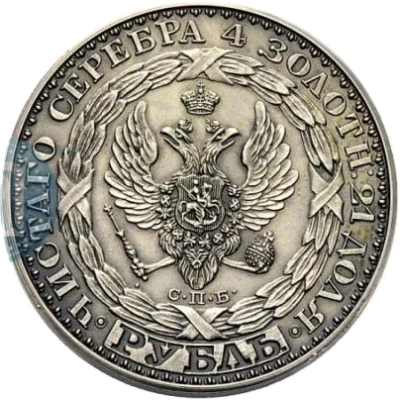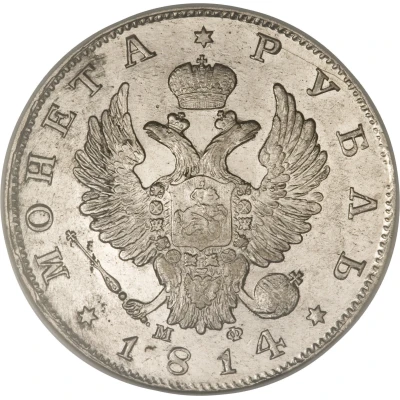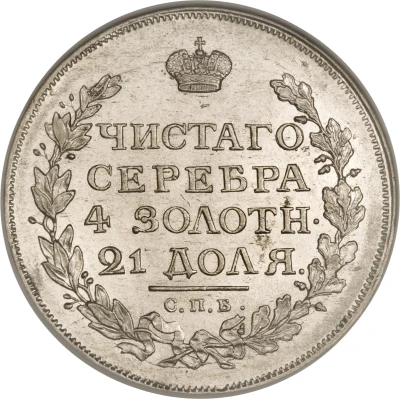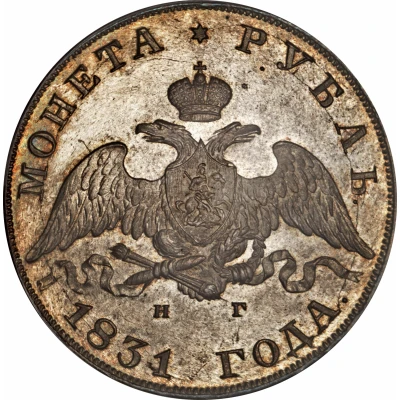


© Sincona AG
Ruble - Constantine Pattern
1825 year| Silver (.868) | 20.73 g | 35.5 mm |
| Issuer | Russian Empire |
|---|---|
| Period | Interregnum (1825) |
| Type | Pattern |
| Year | 1825 |
| Value | 1 Rouble (1 Рубль) |
| Currency | Rouble (1700-1917) |
| Composition | Silver (.868) |
| Weight | 20.73 g |
| Diameter | 35.5 mm |
| Shape | Round |
| Technique | Milled |
| Demonetized | Yes |
| Updated | 2024-10-07 |
| Numista | N#129759 |
|---|---|
| Rarity index | 92% |
Reverse
Crowned double-headed eagle within wreath.
Script: Cyrillic
Lettering:
ЧИСТАГО СЕРЕБРА 4 ЗОЛОТН. 21 ДОЛЯ
С∙П∙Б∙
∙РУБЛЬ∙
Translation:
Pure Silver 4 zolotniks 21 dolyas (parts)
SPB
Ruble
Engraver: Jacob Reichel
Comment
In the images - antique fake.Https://en.wikipedia.org/wiki/Constantine_ruble
The Constantine ruble is a rare silver coin of the Russian Empire bearing the profile of Constantine, the brother of emperors Alexander I and Nicholas I. It was prepared to be manufactured at the Saint Petersburg Mint during the brief Interregnum of 1825 but has never been minted in numbers and never circulated in public. The fact of its existence, classified in Russia until 1886,[1] leaked into European press in 1857.
According to Ivan Spassky, there are eight genuine Constantine rubles of two different types. Five are proof coins complete with edge lettering. A hypothetical sixth coin of this type was probably minted in December 1825 and disappeared without trace. Three coins of the so-called Schubert ruble type have no edge lettering. They are, most likely, intermediate work-in-progress proofs illegally removed from the Mint.
Three Constantine rubles are currently preserved at the Hermitage Museum and the State Historical Museum in Russia and the Smithsonian Institution in the United States. The Hermitage also possesses the three genuine sets of press dies, in different stages of completion, seventeen tin work-in-progress samples and Jacob Reichel's original design on parchment. All other genuine Constantine rubles are in private collections outside of Russia.
The so-called Trubetskoy ruble is a fake Constantine ruble manufactured in the 1860s in Paris, a rare collectible in its own right. Two original Trubetskoy rubles are preserved at the Hermitage Museum and the Smithsonian Institution, the third is privately owned.
Interesting fact
The Pattern Ruble - Constantine (Pattern) 1825 from the Russian Empire is interesting because it was minted during a time of great change in Russia. The coin was minted in 1825, just a year after the death of Tsar Alexander I, who had ruled Russia for over 25 years. This period saw a lot of political and social upheaval, including the Decembrist revolt, which was a failed uprising of army officers who were opposed to the rule of the Romanov dynasty. Despite this turmoil, the Pattern Ruble - Constantine (Pattern) 1825 was still minted using the traditional methods and materials of the time, including silver (.868) and a weight of 20.73 grams. This coin is a fascinating piece of history that provides a glimpse into the tumultuous period of Russian history.



